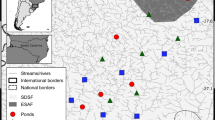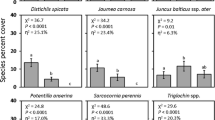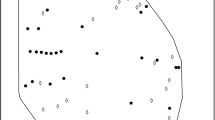Abstract
Land use and land cover change has a marked affect on wetland condition, and different wetland types are affected differentially depending on many abiotic and biotic variables. To assess wetland condition, we have developed a Florida wetland condition index (FWCI) composed of indicators of community structure in the diatom, macrophyte, and macroinvertebrate assemblages for 216 wetlands (n = 74 depressional marsh, n = 118 depressional forested, n = 24 flowing water forested wetlands). Depressional wetlands located along a human disturbance gradient throughout Florida were sampled for each assemblage. Forested flowing water wetlands were sampled for macrophytes only. The landscape development intensity index (LDI) was used to quantify the human disturbance gradient. In general, human disturbance in adjacent areas had the greatest impact on depressional herbaceous wetlands, followed by depressional forested wetlands. Forested flowing water wetlands (i.e., forested strands and floodplain wetlands) were less affected by local conditions, with most of their changes in wetland condition correlated with alterations at the larger watershed scale. Strong correlations between the FWCIs and LDI index scores suggest that changes in community structure can be detected along a gradient of human land use activities adjacent to wetland ecosystems.



Similar content being viewed by others
References
Adamus PR (1996) Bioindicators for assessing ecological integrity of prairie wetlands. EPA600-R- 96/082. National Health and Environmental Effects Laboratory, Western Ecology Division. United States Environmental Protection Agency, Corvallis
Bahls L (1993) Periphyton bioassessment methods for Montana streams. Water Quality Bureau, Department of Health and Environmental Science, Helena
Barbour MT, Gerritsen J, White JS (1996) Development of the stream condition index (SCI) for Florida. A Report to the Florida Department of Environmental Protection, Storm water and Nonpoint Source Management Section. Tetra Tech Inc, Owing Mills
Beck WM (1954) Studies in stream pollution biology I: a simplified ecological classification of organisms. Quart J Florida Acad Sci 17(4):211–227
Brown MT, Vivas MB (2005) A landscape development intensity index. Environ Monit Assess 101:289–309. doi:10.1007/s10661-005-0296-6
Clesceri LS, Greenberg AE, Easton AD (1995) Standard methods for the examination of water and wastewater, 20th edn. American Public Health Association, Washington
Cohen MJ, Carstenn S, Lane CR (2004) Floristic quality indices for biotic assessment of depressional marsh condition in Florida. Ecol Appl 14(3):784–794. doi:10.1890/02-5378
Coles-Ritchie MC, Roberts DW, Kershner JL, Henderson RC (2007) Use of a wetland index to evaluate changes in riparian vegetation after livestock exclusion. J Am Water Resour Assoc 43(3):731–743. doi:10.1111/j.1752-1688.2007.00058.x
Dahl TE (1990) Wetlands—losses in the United States, 1780s to 1980s. Fish and Wildlife Service Report to Congress, Washington DC
Danielson TJ (1998) Indicators for monitoring and assessing biological integrity of inland freshwater wetlands. EPA 843-R-98-002. Wetlands Division Office of Water. United States Environmental Protection Agency, Washington
Doherty SM, Cohen MJ, Lane CR, Line L, Surdick J (2000) Biological criteria for inland freshwater wetlands in Florida: a review of technical and scientific literature (1990–1999). Report to the United States Environmental Protection Agency, Center for Wetlands. University of Florida, Gainesville
Dorman CF, Schweiger O, Augenstein I, Bailey D, Billeter R, de Blust G, DeFilippi R, Frenzel M, Hendrickx F, Herzog F, Klotz S, Liira J, Maelfait J, Schmidt T, Speelmans M, van Wingerden WKRE, Zobel M (2007) Effects of landscape structure and land-use intensity on similarity of plant and animal communities. Glob Ecol Biogeogr 16(6):774–787. doi:10.1111/j.1466-8238.2007.00344.x
Ehrenfeld JG (2004) The expression of multiple functions in urban forested wetlands. Wetlands 24(4):719–733. doi:10.1672/0277-5212(2004)024[0719:TEOMFI]2.0.CO;2
Euliss NH, Mushet DM (1999) Influence of agriculture on aquatic invertebrate communities of temporary wetlands in the Prairie Pothole region of North Dakota, USA. Wetlands 19(3):578–583
Fore LS (2004) Development and testing of biomonitoring tools for macroinvertebrates in Florida streams. Statistical design, seattle, washington. A report for the Florida Department of Environmental Protection, Tallahassee
Fore LS, Grafe C (2002) Using diatoms to assess the biological condition of large rivers in Idaho (USA). Freshw Biol 47:2015–2037. doi:10.1046/j.1365-2427.2002.00948.x
Gerristen J, White J (1997) Development of a biological index for Florida lakes. A Report to the Florida Department of Environmental Protection. Tetra Tech Inc, Owing Mills
Hasle GR, Fryxell GA (1970) Diatoms: cleaning and mounting for light and electron microscopy. Trans Am Microsc Soc 89(4):469–474. doi:10.2307/3224555
Jansen A, Healey M (2003) Frog communities and wetland condition: relationships with grazing by domestic livestock along an Australian floodplain river. Biol Conserv 109:207–219. doi:10.1016/S0006-3207(02)00148-9
Karr JR, Chu EW (1997) Biological monitoring and assessment: using multimetric indexes effectively. EPA 235-R-97–001. University of Washington, Seattle
Karr JR, Dudley DR (1981) Ecological perspectives on water quality goals. Environ Manage 5:55–68. doi:10.1007/BF01866609
King RS, Richardson CJ (2003) Integrating bioassessment and ecological risk assessment: an approach to developing numerical water-quality criteria. Environ Manage 31(6):795–809. doi:10.1007/s00267-002-0036-4
Kirkman LK, Drew MB, West LT, Blood ER (1998) Ecotone characterization between upland longleaf pine/wiregrass stands and seasonally ponded isolated wetlands. Wetlands 18(3):346–364
Lane CR (2007) Assessment of isolated wetland condition in Florida using epiphytic diatoms at genus, species, and subspecies taxonomic resolution. EcoHealth 4:219–230. doi:10.1007/s10393-007-0098-0
Lane CR, Brown MT (2006) Energy-based land use predictors of proximal factors and benthic diatom composition in Florida freshwater marshes. Environ Monit Assess 117:433–450. doi:10.1007/s10661-006-2766-x
Lane CR, Brown MT (2007) Diatoms as indicators of isolated herbaceous wetland condition in Florida. USA Ecol Indic 7:521–540. doi:10.1016/j.ecolind.2006.06.001
Lane CR, Brown MT, Murray-Hudson M, Vivas MB (2003) The wetland condition index: biological indicators of wetland condition for isolated depressional herbaceous wetlands in Florida. A Report to the Florida Department of Environmental Protection. Howard T. Odum Center for Wetlands, University of Florida, Gainesville
Lange-Bertalot H (1979) Pollution tolerance of diatoms as a criterion for water quality estimation. Nova Hedwigia 54:285–304
Lemlich SK, Ewel KC (1984) Effects of wastewater disposal on growth rates of cypress trees. J Environ Qual 13(4):602–604
Lowe RL (1974) Environmental requirements and pollution tolerance of freshwater diatoms. U.S. Environmental Protection Agency, National Environmental Research Center, Office of Research and Development, EPA-670/4–74-005, Cincinnati
Lugo AE, Brown SL (1986) The Ocklawaha river forested wetlands and their response to chronic flooding. In: Ewel KC, Odum HT (eds) Cypress swamps. University Presses of Florida, Gainesville, p 365
Mack J (2001) Vegetation Index of Biological Integrity (VIBI) for wetlands: ecoregional, hydrogeomorphologic, and plant community comparisons with preliminary wetland aquatic life use designations. Final Report to the United States Environmental Protection Agency Grant No. CD985875, vol. 1. Wetland Ecology Group, Division of Surface Water, Ohio Environmental Protection Agency, Columbus. Available via http://www.epa.state.oh.us/dsw.wetlands/wetlands_bioasses.html Cited 10 April 2005
Mack J (2006) Landscape as a predictor of wetland condition: an evaluation of the Landscape Development Index (LDI) with a large reference wetland dataset from Ohio. Environ Monit Assess 120(1–3):221–241. doi:10.1007/s10661-005-9058-8
Marty JT (2005) Effects of cattle grazing on diversity in ephemeral wetlands. Conserv Biol 19(5):1626–1632. doi:10.1111/j.1523-1739.2005.00198.x
Mitsch WJ, Gosselink JG (2007) Wetlands. Wiley, New York
Odum HT (1996) Environmental accounting: emergy and environmental decision making. Wiley, New York
Odum HT, Brown MT, Brandt-Williams S (2000) Folio #1 introduction and global budget. Handbook of emergy evaluation. center for environmental policy, University of Florida, Gainesville
Reiss KC (2004) Developing biological indicators for isolated forested wetlands in Florida. Dissertation, University of Florida
Reiss KC (2006) Florida wetland condition index for depressional forested wetlands. Ecol Indic 6:337–352. doi:10.1016/j.ecolind.2005.03.013
Reiss KC, Brown MT (2005) Pilot Study—The Florida wetland condition index (FWCI): preliminary development of biological indicators for forested strand and floodplain wetlands. A Report to the Florida Department of Environmental Protection. Howard T. Odum Center for Wetlands. University of Florida, Gainesville
Tanner GW, Sandoval LD, Martin FG (1984) Cattle behavior on a South Florida range. J Range Manage 37(3):248–251. doi:10.2307/3899148
Tobe JD, Craddock Burks K, Cantrell RW, Garland MA, Sweeley ME, Hall DW, Wallace P, Anglin G, Nelson G, Cooper JR, Bickner D, Gilbert K, Aymond N, Greenwood K, Raymond N (1998) Florida wetland plants: an identification manual. Florida Department of Environmental Protection, Tallahassee
United Nations Population Fund (UNFPA) (2007) State of the world population 2007: unleashing the potential of urban growth. Available via http://www.unfpa.org/swp/. Cited 2 March 2008
United States Department of Agriculture (USDA), Natural Resource Conservation Service (2002) The PLANTS Database, Version 3.5. National Plant Data Center, Baton Rouge, Louisiana, USA. Available via http://plants.usda.gov. Cited 2001–2004
United States Environmental Protection Agency (USEPA) (2002a) Methods for Evaluating Wetland Condition: Developing and Invertebrate Index of Biological Integrity for Wetlands. EPA-822-R-02-019. Office of Water. U.S. Environmental Protection Agency, Washington
United States Environmental Protection Agency (USEPA) (2002b) Methods for Evaluating Wetland Condition: Using Algae to Assess Environmental Conditions in Wetlands. EPA-822-R-02-021. Office of Water. U.S. Environmental Protection Agency, Washington
US Census Bureau (2007) Total midyear population for the world: 1950–2050. Data from International Data Base, updated 07-16-2007. Available via http://www.census.gov/ipc/www/idb/worldpop.html. Cited 12 March 2008
van Dam H, Mertens A, Sinkeldam J (1994) A coded checklist and ecological indicator values of freshwater diatoms from the Netherlands. Neth J Aquat Ecol 28:117–133. doi:10.1007/BF02334251
van Oene H, Mieleke van Deursen EJ, Berendse F (1999) Plant-herbivore interaction and its consequence for succession in wetland ecosystems: a modeling approach. Ecosystems (N Y, Print) 2:122–138. doi:10.1007/s100219900064
Vivas MB (2007) Development of an index of landscape development intensity for predicting the ecological condition of aquatic and small isolated palustrine wetland systems in Florida. Dissertation, University of Florida
Vulink JT, Drost HJ, Jans L (2000) The influence of different grazing regimes on Phragmites- and shrub vegetation in the well-drained zone of a eutrophic wetland. Appl Veg Sci 3:73–80. doi:10.2307/1478920
Wilhelm G, Ladd D (1988) Natural area assessment in the Chicago region. In: Transactions of the 53rd North American Wildlife and Natural Resource Conference, Louisville, Kentucky, Wildlife Management Institute, Washington D.C., p 361
Winchester BH, Bays JS, Higman JC, Knight RL (1985) Physiography and vegetation zonation of shallow emergent marshes in southwestern Florida. Wetlands 5:99–118
Wunderlin RP (1998) Guide to the vascular plants of Florida. University Press of Florida, Gainesville
Wunderlin RP, Hansen BF (2003) Atlas of Florida vascular plants. From Landry SM, Campbell KN, application development. Florida Center for Community Design and Research. Institute for Systematic Botany, University of South Florida. Available via http://www.plantatlas.usf.edu/ Cited 2003–2008
Young PJ, Keeland BD, Sharitz RR (1995) Growth response of baldcypress [Taxodium distichum (L.) Rich.] to an altered hydrologic regime. Am Midl Nat 133(2):206–212. doi:10.2307/2426385
Zwick PD, Carr MH (2006) Florida 2060: a population distribution scenario for the state of Florida. Geoplan Center at the University of Florida. Available via http://www.1000friendsofflorida.org/Publications/main.asp. Cited 10 March 2008
Acknowledgments
This project was funded in part by a Sect. 319 Nonpoint Source Management grant from the US Environmental Protection Agency through a contract with the Florida Department of Environmental Protection (FDEP). Any opinions, findings, and conclusions or recommendations expressed in this material are those of the author(s) and do not necessarily reflect the views of the FDEP. FDEP staff provided support for this research (particularly R. Frydenborg, A. O’Neal, E. McCarron, J. Espy, T. Frick, J. Jackson, E. Miller, J. Richardson, and L. Wolf). R. J. Stevenson, Michigan State University, and M. Hein of Water and Air Research identified the diatoms. We thankfully acknowledge the input of 12 botanists (G. Anglin, A. Arcuri, D. Austin, K. Bradley, K. Burks, D. Hall, A. O’Neal, J. Poppleton, N. Raymond, B. Tatje, J. Tobe, and W. Zomlefer) who contributed to different surveys for the Floristic Quality Assessment Index. We acknowledge the systems ecology research group at the Howard T. Odum Center for Wetlands. Assistance in field-data collection, laboratory analysis, data entry, and/or feedback on statistical analyzes from E. Bardi, S. Carstenn, M. Cohen, A. Davanzo, M. Friedman, K. Jackson, A. Moore, M. Murray-Hudson, J. Reilly-Brown, V. Rumancik, E. Spurrier, J. Surdick, M.B. Vivas, and M. Yonteck. We are particularly thankful and indebted to the land owners and managers who allowed access to the wetlands throughout Florida. Although this work was reviewed by the USEPA and approved for publication, it may not reflect official Agency policy. Finally, we thank Brad Autrey and two anonymous reviewers for their helpful and constructive comments.
Author information
Authors and Affiliations
Corresponding author
Rights and permissions
About this article
Cite this article
Reiss, K.C., Brown, M.T. & Lane, C.R. Characteristic community structure of Florida’s subtropical wetlands: the Florida wetland condition index for depressional marshes, depressional forested, and flowing water forested wetlands. Wetlands Ecol Manage 18, 543–556 (2010). https://doi.org/10.1007/s11273-009-9132-z
Received:
Accepted:
Published:
Issue Date:
DOI: https://doi.org/10.1007/s11273-009-9132-z




